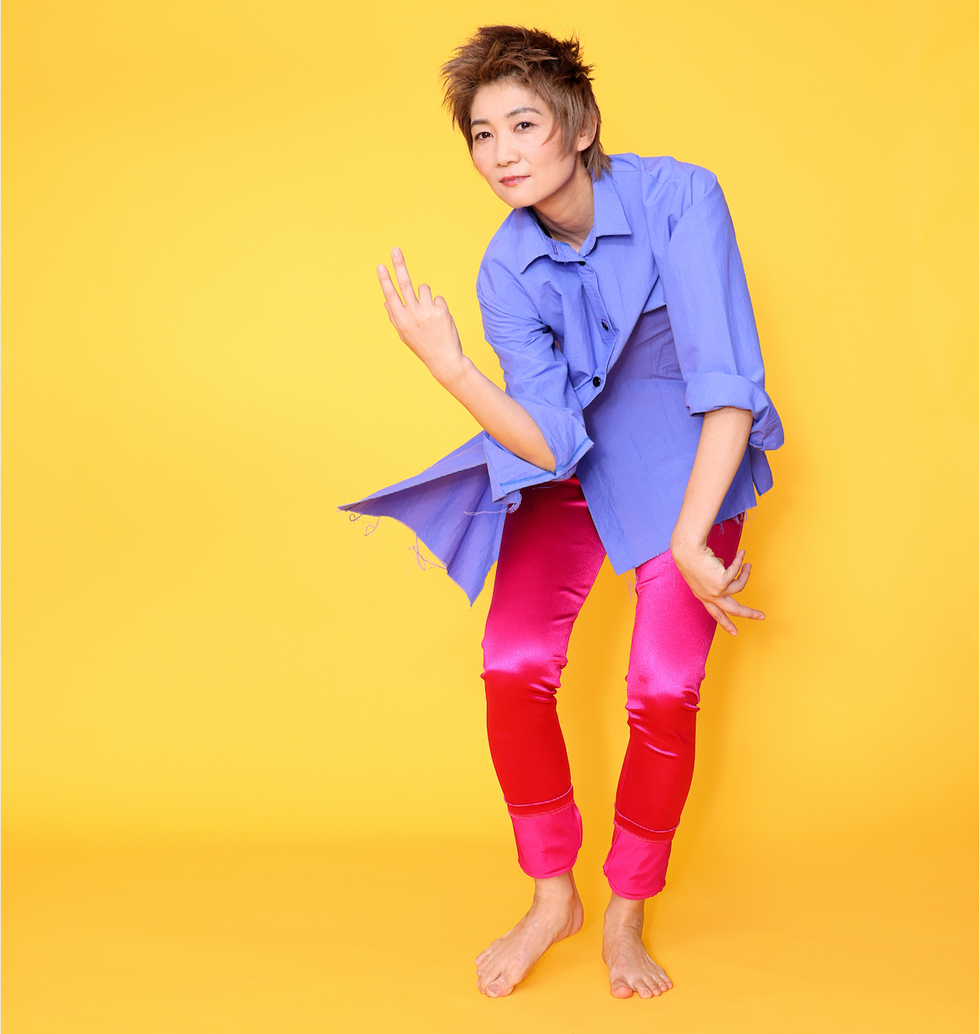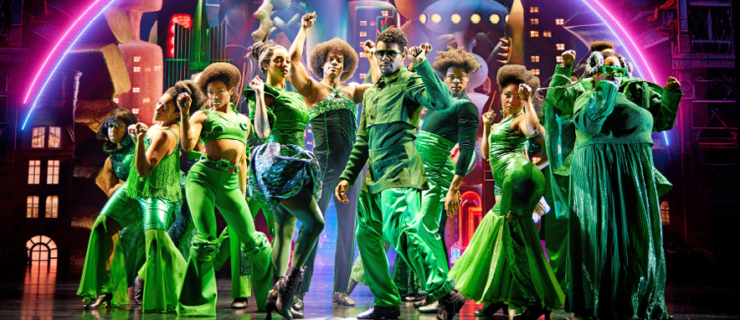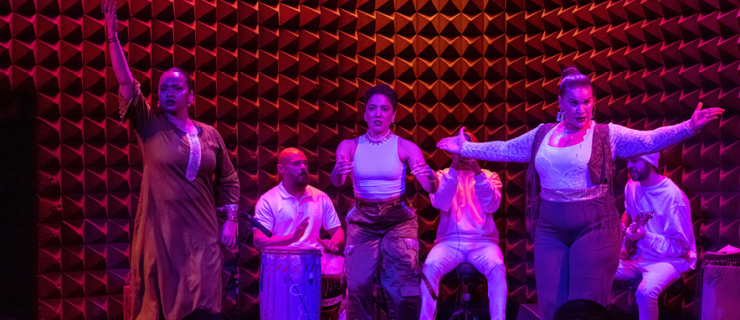Blending Butoh, Cunningham and Her Own Enigmatic Style: Mina Nishimura
Mina Nishimura crawls inchworm style across weathered wood panels. Then, as she cycles through a series of gestural phrases, her facial muscles transform along with her body. Wearing loose sweatpants and brightly colored sneakers, her movement is at once whimsical and structured, playful and abstract. As the five-minute film set to Miles Davis’ “Black Satin” progresses, Nishimura breaks the boundary of her outdoor stage, running loose-limbed across a lushly verdant Vermont landscape until she disappears behind a tree.
“Mina’s movement is very contrarian,” says Cori Olinghouse, a longtime collaborator. “As soon as someone wants to describe it, she’ll do a totally different kind of quality than you’d expect.”
Influences ranging from butoh to Cunningham technique coalesce in Nishimura’s lissome body to create an artistic voice that’s uniquely her own. “There are so many different layers and styles with the postmodern world and butoh world, and different philosophies between West and East,” she says. “I’m always searching for alternate ways of liberating myself.”

That enigmatic quality has made Nishimura a darling of the experimental dance scene. Her long list of performance credits—including quirky, high-profile pop-culture projects—is matched by her own choreographic achievements. But never one to follow expectations, at the height of it all she left her life in New York City to go back to school. She’s now completing an MFA at Bennington College, a haven for artistic exploration nestled in the hills of Vermont.
Nishimura, 42, grew up in Tokyo, a fierce lover of animals, anime and science fiction. Dance played a minor role in her childhood, relegated to a weekly Japanese folk-dance class taught by a friend’s grandmother and the occasional ballet lesson. In high school, Nishimura joined a dance club.
It wasn’t until college at Ochanomizu University that she was introduced to a wider range of contemporary dance forms. While still a student, she took a workshop taught by Kota Yamazaki, a butoh practitioner and choreographer 20 years her senior. Nishimura continued to learn from Yamazaki, and the two developed a close friendship and started dating. Six years later, they got married.
Though Nishimura hadn’t imagined pursuing a dance career, her keen sense of curiosity propelled her to keep learning. In 2001, she moved to New York City, and at Yamazaki’s suggestion enrolled in a training program at the Merce Cunningham Studio. Arriving just months before 9/11, with very little fluency in English, it took Nishimura nearly two years to find her footing.
“I got lost completely,” she says. “I didn’t have a strong dance background, and everyone else seemed to have ballet training and a very architectural body. I couldn’t find a connection between my life and what was happening in New York, especially in the dance field.”
Nishimura also felt her attention pulled in two divergent directions. At the same time that she was training in the postmodern domain of Cunningham, she continued studying with Yamazaki (he moved to the U.S. a year after her arrival) and eventually joined his company, Fluid Hug-Hug. Unlike most modern butoh practitioners who work with set choreography—following in the footsteps of the form’s cofounders Kazuo Ohno and Tatsumi Hijikata—Yamazaki comes from an improvisational lineage created by butoh master Akira Kasai. “It’s quite rare,” notes Nishimura.
While assisting Yamazaki on a cross-cultural exchange in a Senegalese fishing village, Nishimura had something of an epiphany. “In Senegal, everyone knew how to dance, and dance was blended completely into their lives. They didn’t need to go to a studio,” she says. “At that moment I understood that I was the one who was separating my life and my dance practice, and I didn’t need to do that anymore.”
Back in New York, Nishimura returned to the Cunningham studios with a new perspective. “All of a sudden I fell in love with the philosophy of Merce,” she says. “It was not so much about dance technique, but what Merce was trying to do. I felt like a free bird in the studio.”
Nishimura started communicating more freely with the other artists around her, and little by little, opportunities started to come her way; her first professional gig was dancing for RoseAnne Spradlin. Today, Nishimura’s resumé reads like a who’s who of New York’s downtown dance world: Credits include John Jasperse, Vicky Shick, David Gordon, Rashaun Mitchell + Silas Riener, Neil Greenberg and many more.
“Mina, for me, can almost do no wrong,” says Mitchell, who’s known Nishimura since her early days in Cunningham class. “She has a really wild imagination. And there’s a rhythmic clarity and intensity and a particular coordination in her body that are very unexpected, but allow her to move in and out of different qualities and textures.”
Around 2004, Nishimura also started committing herself to choreography, inviting friends to join her in the studio to create duets, trios and eventually larger group works. “Mina has this ability to stretch time and duration and perception that distinctly feels outside a Western compositional sense,” says Olinghouse, who’s worked with Nishimura both as a performer and an archivist. “She’s such a deep experimentalist.”

Andrey Alistratov and HazukiAikawa, Courtesy Late Sea
In recent years, Nishimura has also been sought out for commercial projects. In 2015, she made headlines dancing alongside Sia on “Saturday Night Live.” Wearing a dual-colored wig to mimic the Australian pop star, Nishimura brought what she calls “butoh-ness” to her dancing. With her characteristically idiosyncratic movement and mutable facial expressions, she seemed to play the id to Sia’s uber-controlled performance.
In 2017, Nishimura was again in front of the camera in a phantasmagoric short film created for fashion label Miu Miu’s Women’s Tales series, directed by Celia Rowlson-Hall. The following year she starred in a music video for the alternative rock band Late Sea; her skin painted white but for red eyeshadow, Nishimura dances on a beach, surrealist boxes floating around her.
“The camera really captures subtle nuances sometimes lost in a big theater,” she says of the benefits of film work. “When I do more butoh-style work with my facial expressions, it can be hard to deliver onstage.”
Nishimura has had to work hard to simultaneously hold the Eastern and Western movement philosophies that root her. She explains that in butoh, she aims to destabilize herself, empty her body and sense of self so that she can be easily transformed. But in postmodern dance, identity is key. “I always felt a little strange switching gears from one to another. Of course, each choreographer has a different style, but I started questioning what my own body language is,” she says.
Over the past seven years, Nishimura has started to feel an organic shift, and a sense of clarity around holding many identities at once. “In whoever’s work Mina’s doing, I started seeing her dance rather than her trying to fit in,” says Yamazaki, with Nishimura acting as his interpreter. “Now I can’t keep my eyes off her in performance. It’s hypnotizing, even when she’s doing a subtle movement. She’s magical Mina.”
This is particularly evident in Nishimura’s own work. Her solo Princess Cabbage, which premiered at Danspace Project in 2015, is based on Hijikata’s textural materials. It includes her drawings, which play an important role in her creative process. And in 2019, Nishimura created Hi, Merce! I Have a Question. for a program curated by Mitchell at NYU’s Skirball Center.
“Cunningham and Hijikata were such different figures from completely different social and cultural backgrounds, but they can meet through my body,” says Nishimura. “My body is like a black hole. It absorbs everything, so I feel like I’m receiving a treasure from these great figures.”
Nishimura’s maturation as a creator has also led to a newfound sense of collaboration with Yamazaki. While she’s long played an important role in her husband’s company, the pair have only recently moved towards making and performing new work together. Their first duet, The Otherself, premiered in 2019, and they’re now in process on a new piece, I, Ghost, The, Other, You, which they delved into in residency at Florida State University’s Maggie Allesee National Center for Choreography last December.
“The images we’re using are abandoned, ghostly bodies that have fallen out of the rigid world,” says Nishimura. The duo recently performed an excerpt for presenters in Japan; they hope to debut it at a theater there and also bring it to the U.S.
Shortly before the onset of the coronavirus pandemic, Nishimura left Brooklyn, her home of 17 years, for a new adventure. After guest teaching with Yamazaki at Bennington College three times over the past decade, she’s now a student there herself, completing an MFA in dance. In addition to her studies, Nishimura is teaching and choreographing on Bennington students, and remotely leading a performance project, called “Disappearing Altogether,” at Sarah Lawrence College.
Though they frequently travel back and forth to Japan, Nishimura and Yamazaki are enjoying the quiet tranquility that Vermont offers, but she says she misses the excitement of New York City and her friends there. Nishimura fills her downtime with walks through nature, exploring her reiki practice, and a newfound appreciation for Netflix’s vast library of Korean dramas.
“I thought it would be important to neutralize myself, reset myself and think about what I really want to do in the rest of my life,” says Nishimura of her decision to change course midway through her career. “In New York, every day you get to see dance pieces or art exhibitions, and I felt like I was always reacting to what I saw. Now, instead of living reactively, I want to learn to live a little bit more proactively.”

Princess Cabbage Mathew Pokoik, Courtesy Nishimura
Dual Artist:
Drawing plays an important part in Nishimura’s creative life both in and out of the studio. “I draw a lot, regardless of dancemaking,” she says. But her choreographic notes go beyond simple diagrams. “Instead of drawing lines or dots, sometimes I draw the face of someone, if I want to create a smiley space,” she says. “It helps me to cultivate different layers of images inside myself. Sometimes that image can be language-based, and it can also be drawing-based.”
Nishimura sees her drawings as another expression of her inner life. “She draws her internal states as tone or colors that get inhabited,” says Cori Olinghouse, who’s worked with Nishimura to archive these images. “When I think of Mina, I think of someone who’s able to animate internal landscapes and make invisible forces more visible.”





